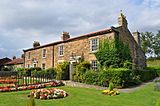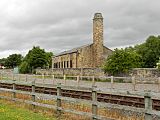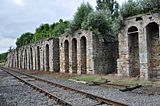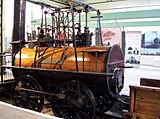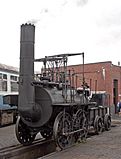Locomotion Museum facts for kids
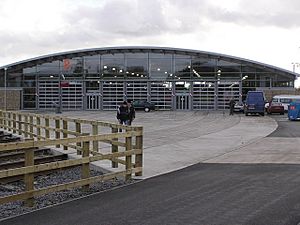
The exterior of the main exhibition hall
|
|
| Established | 22 October 2004 |
|---|---|
| Location | Shildon, County Durham, England |
| Type | Railway museum |
| Visitors | 180,697 (2019) |
| Public transit access | Shildon railway station |
| National Museum of Science and Industry | |
| National Media Museum · National Railway Museum (Shildon Locomotion Museum) · Science Museum (Dana Centre, Science Museum Swindon) | |
Locomotion is an exciting railway museum located in Shildon, County Durham, England. It used to be called Locomotion the National Railway Museum at Shildon. In 2017, its name changed when it joined the Science Museum Group, a family of museums that celebrate science and history.
Contents
Discovering Locomotion: A Railway Adventure
This amazing museum opened its doors on October 22, 2004. The then Prime Minister, Tony Blair, who was also a local Member of Parliament, officially opened it. Building the museum cost about £11.3 million. It was created from the older "Timothy Hackworth Victorian Railway Museum."
Locomotion was built to attract visitors to the small town of Shildon. It was hoped that 60,000 people would visit each year. However, the museum quickly became much more popular! In its first six months, 94,000 people came to explore. Locomotion was even chosen as one of the top five places for the Gulbenkian Prize. This is a very important arts award in the United Kingdom.
As part of big plans for the National Railway Museum, a new building was finished recently. This new space holds even more trains from the national collection. Also, parts of the original museum, like the old coal drops, have been fixed up and look great.
Exploring the Museum Site
The museum is built near Timothy Hackworth's old Soho Works. This area is special because it's on the world's first public railway! This was the Stockton and Darlington Railway, which opened on September 27, 1825. The first train, pulled by Locomotion No 1, took two hours to travel 12 miles from Shildon to Darlington.
Shildon became a major center for building railway wagons. The Shildon wagon works were very important until they closed in 1984.
The Shildon train station was also rebuilt and made modern when the museum was constructed. It is right next to the museum's special train line. Trains from the Tees Valley Line, operated by Northern, stop here.
Museum Highlights and Trail
The museum is set up like a trail, about 1 kilometer (0.6 miles) long. You'll find signs and information points along the way, leading from the car parks to the main building. The museum has several tracks outside the main building. These are used to show off the trains that live there and any special visiting trains.
Your journey starts at the old 19th-century welcome building. The famous Sans Pareil engine used to be displayed here. Now, it's in the main Collection Building.
The second stop is Timothy Hackworth's house. Inside, you can learn about Shildon's history through fun activities. Next is Soho, a stone building that was once a railway workshop. Before that, it was a store for iron. The fourth stop is the old goods shed for the town. Most items coming in and out of Shildon were delivered here by horse and cart. Look closely at the building walls; some parts are made from old stone blocks that were once railway sleepers!
The railway station's parcel office is the next part of the trail. Across the tracks, you can see the old stables. These were for the horses that pulled early wagons on the railway lines. The coal drops were a place where steam locomotives got their fuel. Wagons full of coal were pulled up a ramp. Then, the coal was "dropped" down wooden chutes into the train's tender below.
The trail goes under a road. You'll find a children's playground and a picnic area outside the Collection Building. This is the biggest building at the museum, and it's where the trail ends. Inside, you'll find the main exhibition hall. There's also a special workshop where you can watch volunteers fixing up some of the old trains. The building also has fun interactive games, a cafe, and a shop.
Amazing Exhibits and Locomotives
Locomotion is home to many incredible locomotives from the National Collection. This includes a copy of Timothy Hackworth's Sans Pareil. The original Sans Pareil engine is also at Shildon. This engine was built to compete in the famous Rainhill Trials. These trials helped decide which engine would run the passenger railway between Liverpool and Manchester. After 175 years away, the original Sans Pareil returned to Shildon and is now displayed in the Collection building.
A very famous train, LNER Class A4 4468 Mallard, was temporarily displayed here. It usually lives at the National Railway Museum in York. In 2014, thousands of visitors came to see five sister A4 locomotives. These included 60008 "Dwight D Eisenhower" and 60010 "Dominion of Canada". They had traveled all the way from North America! The "Dominion of Canada" even got a fresh new look in Shildon's workshop.
The main exhibition building holds most of the museum's collection. Here you can see unique trains like the prototype APT-E and Deltic units. The museum also has a wind turbine that helps provide power. There's even a special biodiesel bus to take visitors around the site.
If you want to see a specific train, it's a good idea to check with the museum beforehand.
Steam Locomotives on Display
| Class | Number
(and name if applicable) |
Livery | Image | Current
Status |
Additional Notes |
|---|---|---|---|---|---|
| Hunslet Austerity 0-6-0ST | 3850 Juno | Green |  |
Static | Originally used in ironstone quarries. |
| SR Battle of Britain Class | 34051 Winston Churchill | BR Lined Green | 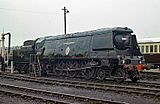 |
Static | Pulled Winston Churchill's funeral train. |
| LMS Stanier Class 5 4-6-0 | 5000 | LMS Lined Black | 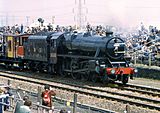 |
Static | The first "Black Five" engine of its kind. |
| Locomotion | 1 Locomotion | Wood lagged | Static | The original engine built for the Stockton and Darlington Railway. | |
| Locomotion replica | 1 Locomotion | Wood lagged | Moved here from Head of Steam – Darlington Railway Museum in March 2021. | ||
| NER Class C1 | 65033 | BR Black |  |
Static (awaiting restoration) | |
| LNER Class V2 | 4771 Green Arrow | LNER Apple Green | 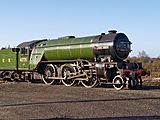 |
Static (potential restoration opportunity) | Now moved to a museum in Doncaster. |
| Sans Pareil replica | Sans Pareil | Green and Yellow painted wood | 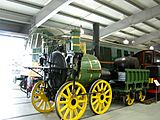 |
Static | |
| Timothy Hackworth entry for Rainhill Trials | Sans Pareil | Exposed Metal |  |
Static | |
| LNWR Class G2 | 49395 | BR Black | 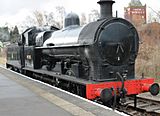 |
Static | |
| Hetton colliery railway locomotive | Lyon | Black | 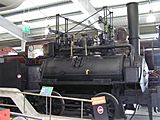 |
Static | |
| NER Class M1 | 1621 | NER Apple Green | 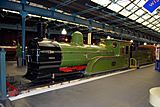 |
Static | |
| GNR Class C1 (large boiler) | 251 | GNR Apple Green |  |
Static | Now moved to a museum in Doncaster. |
| LSWR 0298 Class (Beattie well tank) | 30587 | BR Black |  |
Now on display at the National Railway Museum, York. | |
| South African Class 7A 4-8-0 | 390 | Black | 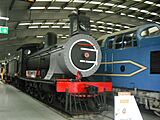 |
Static | Cape Gauge, now on display at the National Railway Museum, York. |
| LNWR Improved Precedent Class | 790 Hardwicke | LNWR Lined Black |  |
Static | |
| Andrew Barclay fireless locomotive | Imperial No. 1 | Imperial Paper Mills Green | 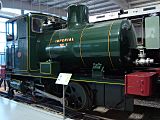 |
Static |
Diesel and Electric Locomotives
| Class | Number
(and name if applicable) |
Livery | Image | Current
Status |
Additional Notes |
|---|---|---|---|---|---|
| LNER Class ES1 Electric Shunter | 1 | NER Lined Green | 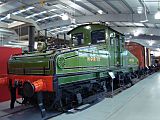 |
Static | |
| British Rail Class 03 Shunter | D2090 (03090) | BR Green | 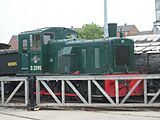 |
Operational | |
| British Rail Class 08 Shunter | 08911 Matey | BR Blue with NRM branding | 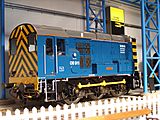 |
Operational | |
| English Electric DP1 | DP1 DELTIC | Blue with grey lining | Static | Prototype Deltic engine. | |
| British Rail Class 41 (HST) | 41001 | Reverse BR Blue & Grey |  |
Static (awaiting inspection) | Prototype HST power car. |
| British Rail Class 43 (HST) | 43102 | InterCity Swallow |  |
Static | Named "The Journey Shrinker." Holds the world speed record for diesel trains. |
| British Rail Class 71 | 71001 | BR Blue | 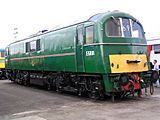 |
Static (under restoration) | |
| British Rail APT-E | APT-E | Reverse BR Blue & Grey | 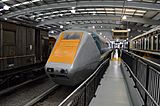 |
Static | A special gas turbine train. |
| Sentinel Diesel-hydraulic Shunter | H001 | RMS Locotec Blue | 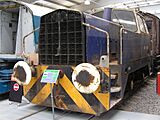 |
Static | Originally for a brewery, then rebuilt for power stations. |
| Wickham Trolley | 960209 | BR Brown | 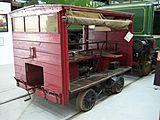 |
Static | |
| Southern Railway Waterloo & City line Shunter (1898) | 75S | L&SWR Salmon |  |
Static |
Diesel and Electric Multiple Units
| Class | Number
(and name if applicable) |
Livery | Image | Current
Status |
Additional Notes |
|---|---|---|---|---|---|
| British Rail Class 306 | 306017 | BR Green with yellow warning panel | 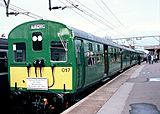 |
Static (awaiting restoration) | Two cars on apron, one car behind workshop. |
| British Rail Class 142 | 142001 | Unbranded Northern |  |
Operational | |
| British Rail Class 414 | 4308 | Network SouthEast on one side, BR Blue and Grey the other |  |
Static | |
| British Rail Class 401 | 2090 | BR Green | 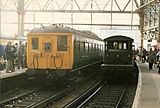 |
Static |
Hauled Rolling Stock and Wagons
| Class | Number
(and name if applicable) |
Livery | Image | Additional Notes |
|---|---|---|---|---|
| British Railways Mark 1 Brake Corridor Composite Coach | 21274 | BR InterCity | 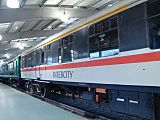 |
|
| BR ZZA Snow Plough | ADB 965232 | Network Rail Black | 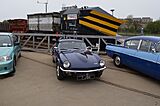 |
|
| SR "Queen Mary" brake van | B56283 | BR Brown | 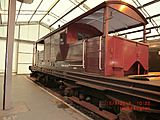 |
Used at museum for carrying passengers. |
| BR merry-go-round train HAA coal hopper wagon | 350000 | BR Grey |  |
The very first HAA wagon built (prototype from Darlington). |
| BR merry-go-round train HAA coal hopper wagon | 368459 | The last of 10,702 HAA wagons built (from Shildon). | ||
| NER Snow Plough | Snow Plough No. 12 | NER Brown | 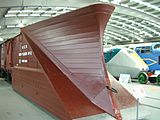 |
|
| Compagnie Internationale des Wagons-Lits Night Ferry Sleeping Car | 3972 | CIWL Blue | 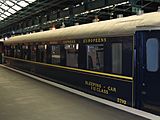 |
|
| High Speed Freight Vehicle | HSFV1 | Grey | 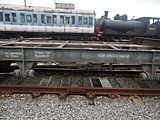 |
The basis for the Class 142 train chassis. |
| Stockton and Darlington Railway Composite Coach (1847) | 59 | S&DR Brown |  |
|
| Stockton and Darlington Railway Composite Coach (1846) | 31 | S&DR Brown | 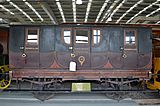 |
Previously displayed at Stockton station. |
Images for kids
See also
 In Spanish: Museo Locomotion para niños
In Spanish: Museo Locomotion para niños
- List of British railway museums
- List of transport museums
- B&O Railroad Museum (US)
- Exporail (Canada)
- Nuremberg Transport Museum (Germany)
- Workshops Rail Museum (Australia)


